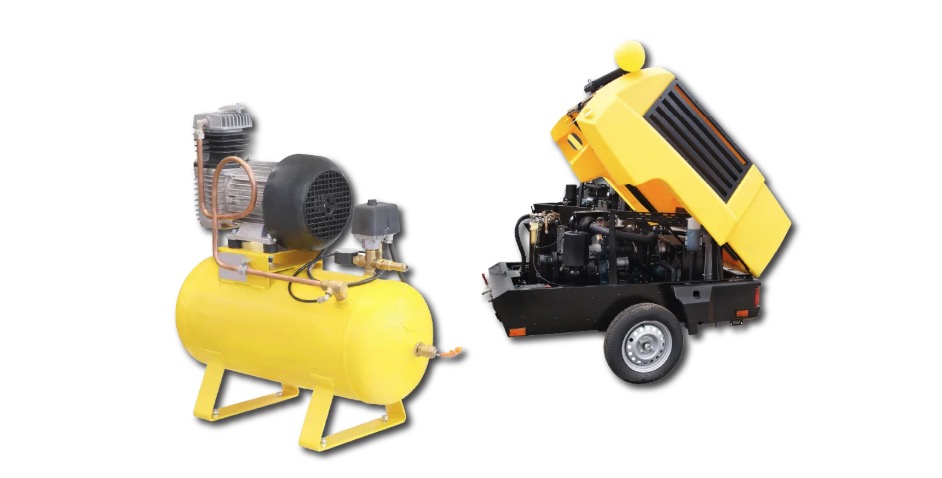
— November 04, 2025
Air compressors are invaluable machines that provide quick, safe and efficient power on construction sites. They work by converting the power from a gasoline, diesel or electric motor into compressed air, which gets stored in a storage tank.
Air compressors are used to power a wide range of pneumatic (air-powered) tools such as demo hammers, drills, nail guns, jack hammers and impact wrenches.
Before choosing the right air compressor for your job, it’s important to understand the various types of air compressors and their uses.
Although air compressors are used in a variety of applications, they’re used most heavily in the construction industry.
In construction, air compressors are used to provide pressurized airflow to pneumatic (air-powered) equipment and hand tools. Pneumatic tools provide a number of advantages over electric or gas-powered tools, such as being lighter, easier to maintain and safer to use.
Since pneumatic equipment and tools don’t have engines, motors or batteries, they are simpler in design and break down less frequently.
A single air compressor can be used to provide airflow to any number of pneumatic tools, allowing all the tools used by your team to be powered with a single device. This cuts down on the hassles associated with battery or fuel-powered devices.
Air compressors come in a variety of shapes and sizes, including many that are highly portable. This makes them an efficient and mobile way to power your tools and equipment on the jobsite.
Air compressors work by using an electric motor or diesel/gasoline-powered engine to force air into an air chamber where the volume is decreased to compress the air. The compressed air is then forced out through an output valve and into a hose which connects to your tools.
As the pressurized air is channeled from your air compressor into your pneumatic tool, it exerts pressure on pistons in the tool that move up and down to generate mechanical power. The power provided by air compressors is powerful, efficient and safer than gasoline, diesel or electric power.
Operating an air compressor is simple and doesn’t require special training. To operate an air compressor, you’ll typically need to follow these steps:
Make sure to keep the air compressor away from any flammable materials. Do not exceed the maximum pressure rating of the air compressor or of any tools connected to it.
If you’re using a gasoline- or diesel-powered air compressor, make sure it is in a well-ventilated area to avoid inhaling harmful fumes.
There are many types and sizes of air compressors used in construction today. Air compressors can be differentiated by the mechanism they use to compress air and their form factor. The two methods for achieving air compression are positive displacement and dynamic displacement.
Positive displacement air compressors compress air by forcing the air into chambers where the volume is decreased to compress the air.
Dynamic displacement air compressors use a rotating blade that constantly turns, forcing air out of a restricted output valve to achieve constant air pressure.
Nearly all air compressors used for construction utilize positive displacement to achieve air compression. Dynamic air compressors mainly have applications in industry and manufacturing. Positive displacement air compressors can be further broken down into three categories:
For most large scale construction applications, rotary screw compressors are the best solution. These compressors are powerful and best equipped to handle continuous use.

In addition to the compression method, you’ll also need to consider the best form factor for your air compressor. Some common form factors for construction air compressors include:
Your needs will determine which form factor you choose. For powering heavy equipment, towable and vehicle mounted air compressors are good options. They deliver the most power and are highly reliable. For work in small areas where mobility is a concern, portable air compressors are an ideal solution.
Regular maintenance is important to keep your air compressor in good working condition and prevent down time.
Here are some key areas of regular air compressor maintenance to include in your maintenance program:
A major advantage of air compressors is they are relatively easy to maintain. Problems with air compressors are uncommon, but can include oil leaks, failing electrical components, hose leaks and broken valves. The best way to avoid these problems is through the implementation of a preventative maintenance program.
Air compressors are vital equipment for construction crews. They provide safe, clean and efficient power to your team’s pneumatic tools and equipment.
At MechLink, we’re here to help you keep the air flowing. Check out our online parts catalog to find quality OEM and aftermarket parts for your air compressor. Still can’t find what you need? Contact one of our parts experts for personalized assistance.

Key components of heavy equipment undercarriage maintenance
December 19, 2025

How to change the hydraulic filter in your heavy equipment and why it matters
December 19, 2025

The best equipment for snow removal: heavy machinery to use this winter
December 18, 2025

How to prevent rust and corrosion on heavy construction equipment
December 18, 2025